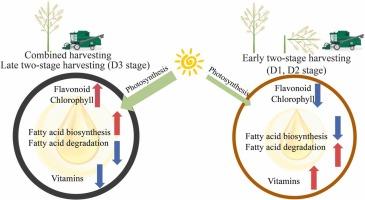优化油菜收获时机:平衡油料产量、代谢质量和田间效率
IF 6.2
1区 农林科学
Q1 AGRICULTURAL ENGINEERING
引用次数: 0
摘要
收获时间对甘蓝型油菜的含油量和营养价值有重要影响,甘蓝型油菜是全球重要的油料作物。本研究考察了联合采收(成熟期直接采收)和两阶段采收(提前采收后田间成熟)对种子油代谢和次生代谢物的权衡。对三种两阶段处理进行了评价,即在开花后23、29和35天扦插植株,然后在田间成熟3-12天。两阶段采收后期(35 DAFF)将含油量保持在与联合采收相当的水平,而早期采收(23和29 DAFF)分别使ZS11品种的含油量降低了5.0 %和2.3 %。机制分析表明,早期收获通过下调关键基因(PsbO、PsbP、PsbQ和天线蛋白)来破坏光合作用,抑制脂肪酸的生物合成,同时加速脂肪酸的降解。早期两阶段收获通过显著抑制关键基因(如TT18和BAN)的表达而损害了类黄酮的生物合成,导致关键类黄酮代谢物(如表儿茶素)的水平降低。有趣的是,虽然这导致DPPH自由基清除活性降低,但早期收获引发了代偿性抗氧化反应,提高了过氧化物酶体的活性和维生素含量,这表明抗氧化策略发生了转变。最重要的是,后期两阶段收获(35 DAFF,成熟6-9天)取得了最佳结果:油和代谢物的分布与联合收获相当,再加上早期的田间清理,促进了作物轮作。这些结果为旨在最大限度地提高油菜籽产量和代谢质量的农民和加工商提供了可操作的见解。本文章由计算机程序翻译,如有差异,请以英文原文为准。

Optimizing harvest timing in rapeseed (Brassica napus L.): Balancing oil yield, metabolic quality, and field efficiency
Harvest timing critically influences the oil content and nutritional value of Brassica napus L., a globally vital oilseed crop. This study examines the trade-offs between combined harvesting (direct harvest at maturity) and two-stage harvesting (early cutting followed by field ripening) on seed oil metabolism and secondary metabolites. Three two-stage treatments—cutting plants at 23, 29, or 35 days after final flowering (DAFF) followed by 3–12 days of field ripening—were evaluated. Late two-stage harvesting (35 DAFF) preserved oil content at levels equivalent to combined harvesting, whereas early cutting (23 and 29 DAFF) reduced oil yield by 5.0 % and 2.3 %, respectively, in the ZS11 variety. Mechanistic analyses revealed that early harvesting disrupted photosynthesis through downregulation of key genes (PsbO, PsbP, PsbQ, and antenna proteins) and suppressed fatty acid biosynthesis, while accelerating fatty acid degradation. Early two-stage harvesting impaired flavonoid biosynthesis by markedly suppressing the expression of critical genes (e.g., TT18 and BAN), leading to reduced levels of key flavonoid metabolites such as epicatechin. Interestingly, while this led to lower DPPH radical-scavenging activity, early harvesting triggered a compensatory antioxidant response, boosting peroxisome activity and vitamin content, suggesting a shift in antioxidant strategies. Crucially, late two-stage harvesting (35 DAFF with 6–9 days ripening) achieved optimal outcomes: oil and metabolite profiles comparable to combined harvesting, coupled with earlier field clearance that facilitates crop rotation. These results provide actionable insights for farmers and processors aiming to maximize both oil yield and metabolic quality in rapeseed production.
求助全文
通过发布文献求助,成功后即可免费获取论文全文。
去求助
来源期刊

Industrial Crops and Products
农林科学-农业工程
CiteScore
9.50
自引率
8.50%
发文量
1518
审稿时长
43 days
期刊介绍:
Industrial Crops and Products is an International Journal publishing academic and industrial research on industrial (defined as non-food/non-feed) crops and products. Papers concern both crop-oriented and bio-based materials from crops-oriented research, and should be of interest to an international audience, hypothesis driven, and where comparisons are made statistics performed.
 求助内容:
求助内容: 应助结果提醒方式:
应助结果提醒方式:


